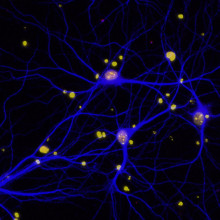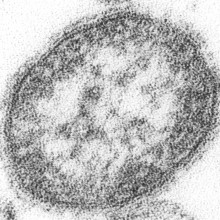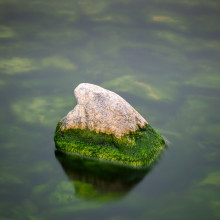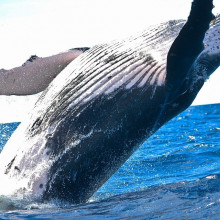A new drug in the fight against Alzheimer’s disease: how does it work? Plus, we’ll also have the latest on measles cases in London, look at the calls to reset the lunar clock, and could algae help people who are seeking to increase vitamin B12 in their diet?
In this episode

- Alzheimer's drug slows mental decline by 35%
Alzheimer's drug slows mental decline by 35%
Bart de Strooper, UK Dementia Research Institute & Richard Oakley, Alzheimer's Society
The phase 3 trial results of a new drug called donanemab has been hailed as a “turning point” in the fight against Alzheimer’s disease. Scientists say that the drug - which slowed cognitive decline by 35% on average - allows people with Alzheimer’s to keep their independence for longer. It targets the build up in the brain of the chemical beta amyloid, which is thought to poison nerve cells and cause cognitive decline in people with the condition. Bart de Strooper is an Alzheimer’s specialist and director of the UK Dementia Research Institute.
Bart - These are antibodies which you inject in the blood, and then they go into the brain and there they attack amyloid plaques and they make the brain clear this amyloid. So in a couple of months you will already see this plaque disappearing. And the really big news is that now for the first time patients which were treated with this medication were followed for two years and we see that they get partially protected against dementia. The process is clearly slowed down 30 to 40%.
Chris - And how were these people medicated? What was the nature of the administration of these antibodies? How often, how much to whom, et cetera?
Bart - They needed an infusion in their veins every four weeks. And that has been done for up to one year. And in some cases up to two years. People were then followed every half year with a new brain scan to see whether the amyloid plaques disappeared.
Chris - And do we know these antibodies actually get into the brain or could the antibodies be doing something else around the body and that triggers the brain to clean itself up? Do we really believe what we think is the mechanism we put the antibodies in, they go into the brain, and they then do the clear up.
Bart - It's a very good question. The problem is that only half a percent of what is injected gets finally in the brain. It binds there to the amyloid plaques, and what I personally think and some other researchers also, is that these antibodies recruit other cells in the brain to help with the cleaning. And these other cells are microglia. These are kind of inflammatory cells, and they go to the plaque where these antibodies are and help to clear those plaques. We think that's the mechanism.
Chris - The individuals who were studied already had some semblance of Alzheimer type change in their brain and in their cognition. Does this argue then that maybe we're at the thin end of the wedge and if we'd started sooner in people whom by some route we could identify as at high risk, potentially the gains would be even bigger?
Bart - I honestly think that that would be the case. Also in the trial as it was presented here, patients which were in an earlier phase of the disease, responded better than the ones which were later in the disease. So I think that we can gain a lot there. It's clear that we should do a big effort to diagnose patients even before they have symptoms you can see in the clinic. So we'll need blood biomarkers or we'll need brain scans and be also much more sensitive. If people start to complain about their memory, we should immediately go further and try to make a correct diagnosis.
Chris - When they said that they could slow the process down by about 30% or so, is that a clinically significant difference? Does it really make a difference to a person's outcome? Or is this a very expensive way of buying someone? A very limited amount of time.
Bart - That becomes a subjective discussion, right? There's a certain risk with the drug and there is no guarantee. People will respond differently, but 30% is the mean. There were 20% more patients which got stabilised on the drug than in the placebo. A year of stabilisation, I think that's really a lot. And so you also need to compare it with other diseases. For cancer, we don't even ask that question. We think it's absolutely normal that you want to try to survive a couple of months longer or a year longer. And it's just by doing that, that we have improved and improved and that nowadays some people live a long life with cancer and I think that will happen also with this type of medications.
Chris - Well let’s dwell a bit more on those clinical impacts and the cost-benefit equation for drugs like donanemab. Richard Oakley is head of research and innovation at the Alzheimer's Society.
Richard - What the data indicates is that by removing this protein so quickly, in fact over 18 months of the trial, the drug removes so much of the protein, the people wouldn't have been able to go on the trial anymore because it's so little. So it's really effective at removing it. And what they estimate is that it gives you about seven months-ish more time of good quality of life. So it slows down the progression of disease enough. You get seven more months of quality of life where you do remember your family, where you do play your sport, hobbies on the weekend, you can still drive, and you can still manage your own finances. So at the moment, we're looking at about a seven month delay. In terms of the progression of the symptoms.
Chris - This is a phase three trial, which is almost the final gateway before the regulator says, 'well okay, we can begin to use this in the population.' The next step will be to weigh up whether or not this is judged to be cost effective. What's your feeling about that? Are they likely to give this the rubber stamp?
Richard - So you're absolutely right. This is phase three, the final step. It now goes to the regulators and in the UK we have two, we have something called the MHRA and they'll look at the data again and say whether the drug is effective and whether it is safe enough to give to people. And then NICE looks at it and says whether we can afford to give it within our healthcare system, we should expect that decision at the end of 2024, early 2025. So we're really excited about allowing that process to happen.
Chris - But which way do you think it's going to go? Because these drugs are not going to be cheap, are they? They are going to be expensive and the health economists are going to have to weigh up buying people improved quality of life for a matter of months versus potentially doing a number of hip replacements and restoring complete quality of life to somebody who gets that rather than this anti Alzheimer's agent.
Richard - Yeah, I mean there's a lot of things to consider. I mean, in terms of the cost of the actual drug in the USA, this drug has been licensed for $25,000 per person per year. So I don't think that is a prohibitive number. I think the bigger question that the health economists absolutely need to look at is the infrastructure around giving these treatments. So we already know only 2% of people currently get the type of early and accurate diagnosis that you need in order to benefit from these drugs. So we need to prove very early on they have Alzheimer's disease and they have to build up this sticky protein, this amyloid in their brain. So a lot of the consideration is, well actually we need to really change the infrastructure of our health service to enable us to work out who can get this treatment, who will benefit from it. I'm hopeful that those regulators will look at the data and conclude that it is safe, effective, and cost effective. These are the first ever disease modifying treatments that actually slow down the progression of Alzheimer's disease, which is the cause of 60% of all dementias in the UK, which is one of the biggest killers in the uk. So I'm hopeful that this will begin a whole new era and then we'll start to see things happening. But I think it's really important that we allow those authorities to make their own decision based on the data they will see.
Chris - David Cameron, our former prime Minister, was making a point earlier in the week that in fact, if you look at how many people are destined to be affected by Alzheimer's disease in the years ahead, and then you work out what the complex care needs for those people are, that in fact if you give people longer and more independence for longer, then it almost pays for itself to an extent.
Richard - There are many, many positives and we've talked about this being the beginning of a whole new era because disease modifying treatments are coming and we believe this would lead to a change in the health and the care system. So I think long term there are an awful lot of benefits and I don't think anyone can debate that. The question I think regulators will look at is, in the short term, do we have the infrastructure to change in order to take advantage of this situation?

- London at risk of major measles outbreak
London at risk of major measles outbreak
Helen Bedford, UCL
The UK’s health authorities have said that London is at risk of a major measles outbreak, with modelling predicting tens of thousands of cases. Officials added that an urgent vaccination push is now needed in a bid to curb an epidemic. Measles kills over 100,000 people a year around the world, most of them children, but it’s also a severe disease for adults too, causing fever, pneumonia, and even swelling of the brain. Helen Bedford is a professor of children’s health at University College London. She is an expert on childhood vaccination and has spent the past 30 years conducting research into vaccine uptake.
Helen - In this country we have very high uptake of vaccination. But even so, it's not high enough to really control certain diseases. And measles is in particular a problem because it is very, very, very infectious. And to keep measles away completely, you have to have really high levels of vaccine uptake, which we simply don't have in this country.
Chris - And how high is really high?
Helen - Really high is 95% for both doses of the vaccine because we recommend that people have two doses of a vaccine that contains measles, which is known as MMR - measles, mumps, and rubella vaccine.
Chris - And what sorts of levels of vaccination, if we are not at 95%, are we at then?
Helen - In England, at two years of age, 89.5% of children have had one dose of MMR. So that sounds really high, but it really isn't high enough. And the real problem is that we have variation in uptake around the country. So if you go to London, and this is where the real problem is, the real risk of having an outbreak is at the moment, uptake is very much lower. Overall, across London it's about 82%. But then go to different parts of London, go to Hackney, which is in the east end. The uptake there is 65%, four in 10 children are not getting their MMR vaccine.
Chris - And obviously if you've got hotspots of low uptake, that's a Tinder box for an outbreak there, isn't it? If you've got lots of susceptible people all in one area.
Helen - Absolutely. That's the problem. What we're really worried about is when you get an outbreak, you tend to get more cases amongst under vaccinated communities. We know who those communities are, people who reject vaccination, people who move around. So in London there's a lot of population mobility, people who've recently come into the country. And then there'll be certain communities with particular cultural views, travelling communities, those sorts of communities at particular risk of measles outbreaks.
Chris - Has this become more acute more recently, or are we now just talking about it because we want to do something about it?
Helen - It has become more acute. Recently the UK Health Security Agency has done some modelling. They've basically worked out that at the level of vaccine uptake we have now, I'm talking about young children, but we've also got a lot of young adults who weren't vaccinated when they were babies 20 years ago. And all these groups have built up in the population and they've accounted for all this in their modelling exercise and concluded that unless we improve vaccine uptake, we could see an outbreak as big as between 40,000 and 160,000 cases.
Chris - What can we do about it, then? Obviously raise awareness, which is what we're doing here and urge parents to do this. But if you are in those young adult groups that you were discussing, is it too late for you or can those individuals, just like young babies, go and get an MMR?
Helen - Very, very luckily, there's no upper age limit for MMR vaccine. Anybody can get it. We need to get this message over very, very firmly that it's not too late. And it's really good to do it now at the beginning of the summer before people start travelling abroad, because we are seeing measles cases in Europe and in other countries too. It's very easy to go to the GP and it's best to have two doses of the vaccine. You need to have a month apart. Fortunately, we can stop this outbreak in its tracks if we can improve vaccine uptake and if we can encourage people that haven't been vaccinated to take the vaccine up.
Chris - A theoretical risk is one thing, but have we got evidence that measles really is on the move yet?
Helen - For the first six months of this year, we've seen 128 cases. It's already far more than we had in the whole of last year. Most of the cases are in young children under the age of 10 years. But the thing with these childhood diseases like measles, they're really, really nasty when you are a baby. But they can also be extremely nasty when you're an adult and you often have very high rates of people with measles going into hospital when they're adults. They can be really ill.
Chris - You mentioned that there are particular groups that are contributing to these higher numbers of unvaccinated individuals. Is that the focus then of various initiatives to try and address that? What are we doing about it?
Helen - Well, one of the things we need to do is remind parents. If you literally do something as simple as send parents a vaccination reminder, that's really important. Make it easier for parents to have their children vaccinated and perhaps use some of the initiatives that you used during the pandemic when we were offering vaccination in different places. So not just the GP surgery, but maybe offering them in community centres and family hubs where young families go. We've certainly seen this in the past, because we've had similar sort of situations to this in the past, where people have done things like literally painted a bus called the spotty bus and driven it around parking in supermarket car parks and offering vaccination to families who are in the vicinity.

- Parts of the Moon are older than we think
Parts of the Moon are older than we think
Richard Hollingham, Space Boffins
The “man in the moon” might be 200 million years older than we thought: that’s owing to a fresh analysis of the impact craters and samples recovered from the lunar surface by the Apollo missions. Richard Hollingham is a science journalist, author, and presenter of the Space Boffins podcast.
Richard - You have to think in geological time here, which I really struggle to get my head around. So the solar system formed around 4.6 billion years ago and the Moon formed very shortly after. And this period of the solar system formation was really chaotic. It was terrifying. If you imagine there's that scene in Star Wars, in fact, there's several scenes in Star Wars, where the Millennium Falcon bombs through an asteroid field. That's what the solar system was like, at least in the plane of all the material around the Sun. And so the Moon was formed by this Mars sized object hitting the Earth and pinging out to form the Moon and ending up in orbit. And we know that from the Apollo missions, we know that from these rocks, astronauts brought back 382 kilograms of rock from the Moon. So we know that, and this latest research really is just putting some refinement on the dates of sort of what happened afterwards, of when things hit the Moon, when events happened on the Moon. I guess painting a bit more of a picture of the early solar system.
Chris - Why does that matter? I don't mean that in a sniffy way, as in how does that inform, in terms of understanding the timing, what was going on when?
Richard - The Moon is almost like a perfectly preserved relic of the early solar system. On the other hand, we've had all sorts of tectonic movements. We've got the tectonic plates moving around volcanoes, earthquakes. It's really difficult to piece together what the early Earth was like. But we can see now what the early Moon was like. And just putting dates on this gives us a much better understanding of what the early solar system was like. We can use that to apply to other solar systems as we start to discover other solar systems, but also use it perhaps to figure out, well when did it all calm down and what sort of conditions would there need to be for life, whether that's on Earth or whether that's on Mars. So it's another little bit of the jigsaw of information on this.
Chris - So if we get a timeline on when things were and weren't hitting the planet because the Moon doesn't have tectonics, so it preserves the sort of timeline with all those crater impacts, we can tell when they were happening on the Moon and getting the dates right kind of matters. We know the Earth was probably subject to the same sort of thing. Then it tells us a bit more about the conditions at that point in Earth's history, which is pretty important for when we think life was beginning to get started.
Richard - Absolutely, yeah. Gives us a really good sense of what the early solar system was like and we've just learned so much from these missions to the Moon and still I find it remarkable. We're still learning from the Apollo missions. I mean the last one of those was in 1972. I mean, it is just amazing.
Chris - It is amazing. I'm quite glad we've got you here because I was going to ask you, because India is about to launch another mission to the moon and this will be the fourth country to land on the moon and they're heading where NASA wants to head, aren't they? Down to the south pole of the moon. What can you tell us about that?
Richard - Yeah, so they launched last week. It's on its way to the Moon, due to touchdown in August. So yeah, as you say, the fourth country to land on the Moon. But this is going to the lunar South Pole. If it works, if it lands softly, they've got a rover. This will be the first mission soft landing and exploring the lunar South Pole. That matters because an earlier Indian mission found evidence of water ice in that area and astronauts are heading to the lunar South Pole. So the next astronauts to walk on the Moon will probably be going there. If there's water there, well, that's great news because that means they can, in future, if we have a lunar base or whatever, use that water to live on.

- Eating algae as part of a balanced diet
Eating algae as part of a balanced diet
Alison Smith, University of Cambridge
Algae might be the nemesis of pond owners everywhere - but researchers at the University of Cambridge think it could help people who are seeking to increase the amount of vitamin B12 in their diet. B12 - for the uninitiated - is a key nutrient involved in blood and nerve cells. However, people with plant-based diets may not get enough of it, and algae might be able to help them. Professor Alison Smith is the head of the plant metabolism group at the University of Cambridge.
Alison - Algae are very simple plants. Most of them live in water and they take up vitamin B12 from the liquid that they live in. So bacteria that are also living in the same place, like in a pond, a river, or even the sea, the bacteria make the B12 and then algae take it up.
Chris - And the algae conveniently package it for us. And if we eat the algae, we get the B12.
Alison - Exactly. Whereas plants don't do that.
Chris - And that's why the emphasis in your world is on algae as being a possible way to remediate this problem with a plant-based diet.
Alison - That's right. Yes.
Chris - So tell us about how this might work then. What would be the idea here?
Alison - What we've been doing in my research is to investigate the interactions between algae and bacteria and trying to understand the processes by which the B12, which is a large molecule, can be taken up by these simple plants, they're unicellular plants and also which types of bacteria are best for the algae to live with. There are various types of B12 and the type that we need, called cobalamin, is also preferred by algae. So that's an important nuance. So it makes the B12 that you find in the algae, the same as the ones that humans want. But there are some bacteria that make different types of B12. There are lots of different ones and there's one in particular called pseudo cobalamin. And this is made by certain bacteria and algae can't really take that up and neither can humans. So knowing which types of bacteria to grow your algae with is obviously important if you're trying to make a food which is rich in B12 that humans can use.
Chris - So your argument would be, now you've identified who the algae need to have as a good bacterial bedfellow to get the B12 that they need. And what would we do? Would we grow lots of algae? A bit like we make Marmite from growing fungi or yeasts and we concentrate it to make a delicious snack. We would make algae based snacks.
Alison - It depends on your point of view.
Chris - <laugh>. Oh, you either love it or you hate it. Alison. It's said it divides people, doesn't it? Marmite. But would that be the idea then you do the same thing for algae and that's how we would get the B12 in our diet. But a vegan, for instance, would be very comfortable eating that because it's a plant.
Alison - That's right. Yes, you can make B12 from bacteria and that's how it's made when you prepare pills from it. But if you want to have a sort of natural diet, you can grow algae with benign bacteria, their own microbiome, and they will then take up the B12. Interestingly, yeast also doesn't make B12 and Marmite, which comes from the yeast, actually have B12 added to it.
Chris - Oh, so you could have a match made in heaven here <laugh>.
Alison - Horrible, horrible Marmite
Chris - <laugh>. Watch it. You don't, you don't want to have Marmite on the phone to you <laugh>. But could you add the algae to the Marmite perhaps? Is there a collaboration here? <laugh>?
Alison - I guess you could do that as well, <laugh>. But you know, I'd like to stick to it being green. How about that?

- Do all whales have the same ancestor?
Do all whales have the same ancestor?
Thanks to Dr Ellen Coombs for the answer.
Will - Did you know the closest living relative of cetaceans, that’s whales and dolphins, is the hippopotamus? Well, whilst that might be true, the word closest in this context… isn’t all that close. In fact cetaceans split off from the rest of the mammal world around 55 million years ago. Since then, they have evolved into a hugely diverse array of marine mammals. Today, there are two main groups: the baleen whales, which filter krill with giant plates in their mouth; and toothed whales, which have… teeth. But did all of this variety stem from one lone organism? Dr Ellen Coombs from the Smithsonian Institution takes us back in time, and to perhaps a rather unlikely source.
Ellen - If we travel back about 50 million years to what is now Pakistan, we would see a goat sized mammal called Pakicetus. Pakicetus had fur, four legs, a long tail, and importantly, its nostrils were on the tip of snout, just like in any other terrestrial mammal. But despite appearances, Pakicetus was actually the first known whale.
Will - At some point around that time, Pakicetus realised that there was a lot of rich pickings to be had in the warm and vibrant waters of the Tethys Sea, and so began an amphibious life of catching fish, and whatever else was in those waters.
Ellen - Gradually over time, Pakicetus and later Archaeoceti became beautifully adapted to the aquatic lifestyle where they evolved high frequency underwater hearing, powerful tails. They lost their hind limbs and their nostrils moved from the tip of the snout to the top of the head to facilitate breathing at the water's surface. So in around eight to 12 million years, these ancient whale ancestors looked much more whale-like. These animals evolved from being land dwelling to fully aquatic in an evolutionarily short eight to 12 million years.
Will - But it wouldn’t be unreasonable to think that toothed and baleen whales came from two different organisms, given how different they are today. The two groups diverged an estimated 39 million years ago, but how the transition to baleen came about is less clear. Obviously Pakicetus had teeth, so toothed whales came first, and it was assumed that baleen evolved from teeth. but stronger evidence now suggests that these whales lost their teeth completely before growing baleen separately. And in the interim, sucked fish directly down their throats. Isn’t nature a marvel? But whatever the case, all of this evolution and speciation happened once whales were well established in the water, so we can be sure that all forms of whale including the largest organism ever to have lived, come from a humble beach side mammal.
Thank you very much to Bert for the question, and Dr Ellen Coombs for providing an answer. If you have a query of your own, do send it in to chris@thenakedscientists.com










Comments
Add a comment